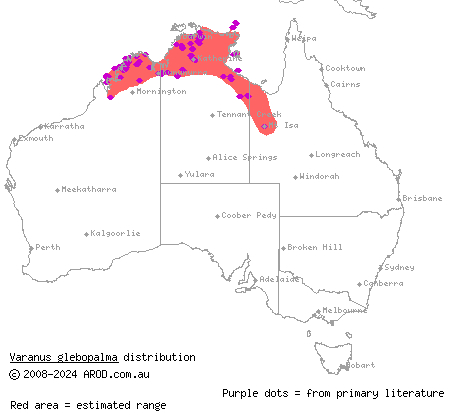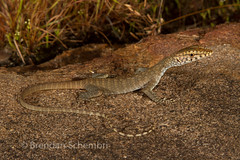Post by Ceratodromeus on Nov 28, 2015 10:06:29 GMT 5
Black-palmed Rock Monitor - Varanus glebopalma

Scientific classification
Kingdom:Animalia
Phlyum: Chordata
Subphylum: Vertebrata
Class: Reptilia
Order: Squamata
Family:Varanidae
Genus: Varanus
Subgenus:(Odatria)
Species: V.(Odatria) glebopalma
Description
This is a very lean species of varanid, with a long gracile neck and correspondingly long tail.They have a body color similar to the Perentie - Varanus giganteus, a standardwhite with various black mottled markings running down its entire body. Juvenile animals have a more subdued, light brown coloration. The throat and underbelly are a white coloration in both juveniles and adults, and they possess light black barring. Adult males are larger then females are, measuring around 290mm(11.4in) in snout-ventral length and weighing 240g, while females measure roughly 245mm(9.6in) in snout-ventral length, and weigh 135g. Large individuals of the species can measure up to 397mm(15.6in) in snout-ventral length, and upto 1.1m(3.6ft) in total length{1,2}.

Geographic range
This species is endemic to North western Australia, ranging from western Kimberly, to northwest Queensland. these monitors, as the common name may suggest, habitate large rocky outcrops; something worth mentioning is these monitors are absent in areas that lack rocky terrains. It is exclusively terrestrial in nature, and will not climb trees even if pursued. Males have large home ranges and are very territorial, though there is some degree of overlap between males' home ranges for the most part. Any where from 2-4 females may be within the home range of any given male.

Dietary habits
V. glebopalma is an ambush predator,utilizing its rocky terrain to launch itself at unsuspecting prey animals. They sit upon large rock,scanning the substrate below, and once they lock their eyes on potential prey they have been known to jump off of their perch, run the prey animal down,grab it, shake it to death, and swallow it whole. These varanids are very quick and agile animals, which is beneficial for the predatory lizards' sucess, as its diet consists primarilyof small lizards. Animals taken as prey of the black palmed rock monitor include terrestrial skinks(Ctenotus spp.), legless lizards (Pygopodidae) smaller monitors (V.(Odatria)spp.), frogs (Litoria spp.) grasshoppers, spiders, and beetles{1,3}.
Reproduction
Black palmed rock monitors attain maturity at approximately 170mm(6.6in) in snout-ventral length in both sexes.{1,4}Reproduction occurs from September-October, and though egg clutch deposition has not been documented in wild animals, captive females lay anywhere from 3-7 eggs, with larger females producing larger clutches. When the young hatch, they measure approximately 85-90mm(3.3-3.5in) in snout-vent length{1}.

References
{1} Pianka, Eric R., Dennis King, and Ruth Allen King. Varanoid lizards of the world. Indiana University Press, 2004.
{2} Thompson, Graham G., and Philip C. Withers. "Comparative morphology of Western Australian varanid lizards(squamata: Varanidae)." Journal of Morphology 233.2 (1997): 127-152.
{3} Losos, JONATHAN B., and HARRY W. Greene. "Ecological and evolutionary implications of diet in monitor lizards." Biological Journal of the Linnean Society 35.4 (1988): 379-407.
{4} Lyneham, Australian Capitol, and Storer Hall. "Reproductive Biology and Diets of Goannas (Reptilia: Varanidae) from Australia."

Scientific classification
Kingdom:Animalia
Phlyum: Chordata
Subphylum: Vertebrata
Class: Reptilia
Order: Squamata
Family:Varanidae
Genus: Varanus
Subgenus:(Odatria)
Species: V.(Odatria) glebopalma
Description
This is a very lean species of varanid, with a long gracile neck and correspondingly long tail.They have a body color similar to the Perentie - Varanus giganteus, a standardwhite with various black mottled markings running down its entire body. Juvenile animals have a more subdued, light brown coloration. The throat and underbelly are a white coloration in both juveniles and adults, and they possess light black barring. Adult males are larger then females are, measuring around 290mm(11.4in) in snout-ventral length and weighing 240g, while females measure roughly 245mm(9.6in) in snout-ventral length, and weigh 135g. Large individuals of the species can measure up to 397mm(15.6in) in snout-ventral length, and upto 1.1m(3.6ft) in total length{1,2}.

Geographic range
This species is endemic to North western Australia, ranging from western Kimberly, to northwest Queensland. these monitors, as the common name may suggest, habitate large rocky outcrops; something worth mentioning is these monitors are absent in areas that lack rocky terrains. It is exclusively terrestrial in nature, and will not climb trees even if pursued. Males have large home ranges and are very territorial, though there is some degree of overlap between males' home ranges for the most part. Any where from 2-4 females may be within the home range of any given male.

Dietary habits
V. glebopalma is an ambush predator,utilizing its rocky terrain to launch itself at unsuspecting prey animals. They sit upon large rock,scanning the substrate below, and once they lock their eyes on potential prey they have been known to jump off of their perch, run the prey animal down,grab it, shake it to death, and swallow it whole. These varanids are very quick and agile animals, which is beneficial for the predatory lizards' sucess, as its diet consists primarilyof small lizards. Animals taken as prey of the black palmed rock monitor include terrestrial skinks(Ctenotus spp.), legless lizards (Pygopodidae) smaller monitors (V.(Odatria)spp.), frogs (Litoria spp.) grasshoppers, spiders, and beetles{1,3}.
Reproduction
Black palmed rock monitors attain maturity at approximately 170mm(6.6in) in snout-ventral length in both sexes.{1,4}Reproduction occurs from September-October, and though egg clutch deposition has not been documented in wild animals, captive females lay anywhere from 3-7 eggs, with larger females producing larger clutches. When the young hatch, they measure approximately 85-90mm(3.3-3.5in) in snout-vent length{1}.

References
{1} Pianka, Eric R., Dennis King, and Ruth Allen King. Varanoid lizards of the world. Indiana University Press, 2004.
{2} Thompson, Graham G., and Philip C. Withers. "Comparative morphology of Western Australian varanid lizards(squamata: Varanidae)." Journal of Morphology 233.2 (1997): 127-152.
{3} Losos, JONATHAN B., and HARRY W. Greene. "Ecological and evolutionary implications of diet in monitor lizards." Biological Journal of the Linnean Society 35.4 (1988): 379-407.
{4} Lyneham, Australian Capitol, and Storer Hall. "Reproductive Biology and Diets of Goannas (Reptilia: Varanidae) from Australia."


